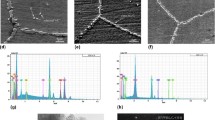Conclusion
Summarizing we can conclude that:
-
1)
At the state of the maximum CRSS, that is in the state of quasiregular arrangement of precipitates, the proposed theory gives satisfactory results in all considered cases.
-
2)
This simple theory explains also satisfactorily hardening during ageing in regime III, but only for (a) and (c) concentration regions.
-
3)
On the basis of presented calculations it seems that edge dislocations rather than screw ones are controlling the initiation of deformation at least with respect to CRSS.
-
4)
Finally, the Ti concentrations (c < 1·3 at% Ti) are sufficiently low to admit tunnelling through a regular array of obstacles. This effect could be a possible reason for overageing observed in regime IV. In fact, for specimens with higher concentration, e.g. 1·6 at% Ti, no overageing has been observed up to 850 hours [14].
Similar content being viewed by others
References
Michels H. T., Cadoff I. B., Levine E.: Metall. Trans.3 (1972) 667.
Knights R., Wilkens P.: Acta Metall.21 (1973) 1503.
Hakkarainen T., Doctor of Technology Thesis, Helsinki University of Technology, 1971.
Cornie J. A., Datta A., Soffa W. A.: Metall. Trans.4 (1973) 727.
Datta A., Soffa W. A.: Acta Metall.24 (1976) 987.
Soffa W. A., Greggi J.: Scr. Metall.12 (1978) 525.
Wagner R.:in Strength of Metals and Alloys, Proc. ICSMA 5, vol. 1, (eds. P. Haasen, V. Gerold, G. Kostorz), Pergamon Press, Toronto, 1979, p. 645.
Greggi J., Soffa W. A.:in Strength of Metals and Alloys, Proc. ICSMA 5, vol. 1, (eds. P. Haasen, V. Gerold, G. Kostorz), Pergamon Press, Toronto, 1979, p. 651.
Kratochvíl P., Saxlová M., Pešička J.:in Strength of Metals and Aloys, Proc. ICSMA 5, vol. 1, (eds. P. Haasen, V. Gerold, G. Kostorz), Pergamon Press, Toronto, 1979, p. 687.
Laughlin D. E.: Acta Metall.24 (1976) 53.
Balik J., Saxlová M.: Czech. J. Phys. to be published.
Schwarz R. B., Labusch R.: J. Appl. Phys.49 (1978) 5174.
Dotsenko V. I., Kratochvíl P., Pešička J., Wielke B.: Czech. J. Phys. B31 (1981) 209.
Mencl J., Vostrý P.: Czech. J. Phys. B31 (1981) 221.
Čižinský P., Pešička J.: Czech. J. Phys. to be published.
Author information
Authors and Affiliations
Rights and permissions
About this article
Cite this article
Saxlová, M., Balík, J. Precipitation hardening in dilute Cu-Ti alloys. Czech J Phys 31, 215–220 (1981). https://doi.org/10.1007/BF01959445
Received:
Issue Date:
DOI: https://doi.org/10.1007/BF01959445




